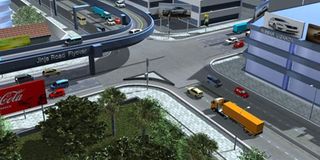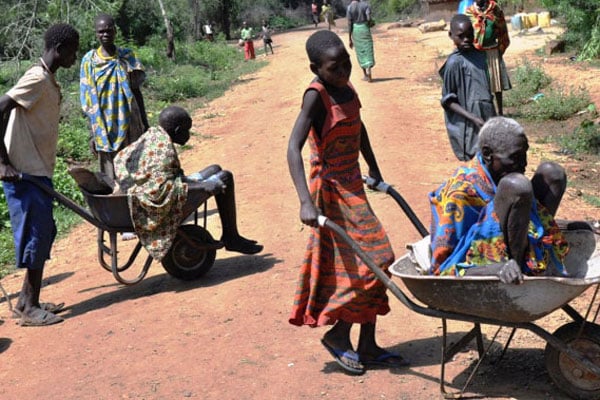Prime
Is KCCA jumping the gun over the Kampala-Jinja highway?

An artistic impression of the proposed Kampala-Jinja Road reconstruction. However, skeptics say implementing such a project requires a comprehensive planning structure, which KCCA has not done. PHOTO BY ABUBAKER LUBOWA.
What you need to know:
Experts pour cold water on the capital’s flagship infrastructure project as City Hall admits the blue-print for the Shs9 billion contract it has already awarded, is not even ready. Saturday Monitor’s Frederic Musisi & Tabu Butagira look at the contending issues.
Kampala.
A proposed flagship infrastructure project to widen the section of Jinja Road connecting to Kampala Central Business district into a six-lane carriage way is being scorned by experts as not well-thought out, and unlikely to abate traffic gridlock.
The Kampala Capital City Authority (KCCA) executive director, Ms Jennifer Musisi, broke news of the re-construction on her Twitter handle in August, announcing that works should have commenced early last month. The exercise stalled, and City Hall now expects that Energo Projekt will begin the road expansion later this month.
According to KCCA officials, three lanes on either side of a separator alienating oncoming traffic will be created when the work is completed in about six months. The section of the thoroughfare to be upgraded stretches from Katalima Road junction in Nakawa satellite town to the light-controlled Jinja Road intersection, meaning KCCA will dig up the road on which it in the past year spent billions to beautify.
City Hall officials say an expanded Jinja Road will ease motorised traffic flow in and out of the central business district, where most gainful employment activities are concentrated. Infrastructure experts agree a broader motorway permits speedy traffic movement, but challenge the KCCA plan because it is piecemeal and does not address likely heavier traffic build-up at narrower points where the widened road merges into narrower carriageways after the Nakawa and Jinja Road junction.
Dr Kiggundu Amin Tamale, a Makerere University lecturer at the Department of Architecture and Physical Planning, discounted the proposed project as “another problem with the poor planning in this country mainly to eat money.”
“Planning for a city goes beyond expanding roads alone, which KCCA is majorly focusing on while turning a blind eye on issues such as the destination of vehicles and parking spaces,” he said.
Dr Tamale is not alone. Officials of Uganda National Roads Authority (UNRA), a central government agency responsible for national roads, excluding those under KCCA jurisdiction, say the city’s approach is a non-starter.
First, if each lane is approximately three metres wide, a rough estimate shows a minimum of 25 metres of space would be required to enlarge the carriage ways and as well provide for the island separating them; the side-drains, pedestrian walkways and road reserve for, among other things, conveying utilities.
Such vast land may be secured from Jinja Road junction if KCCA encroaches on southern part of Centenary Park, but no big chunk will be available from around Jinja Road Police Station and on the stretch straddling via Game Shopping Mall to Nakawa Township Centre.
The alternative would be for KCCA to knock down private roadside property, which would require public sensitisation and prior compensation none of which KCCA has done or appears ready to do given the stated project take-off timeline.
So, how does City Hall escape from the trap and justify value-for-money in the planned Shs9 billion investment?
Mr Johnson Akankwasa, the project site supervisor, said “the stretch between Lugogo Indoor Stadium and Game stores shall not be expanded because that width is too small and we don’t have money.” He added: “It will maintain a two-lane driveway because widening it may involve compensations, money KCCA doesn’t have although a few modifications will be carried out. Poor planning in Kampala did not start yesterday or today.”
KCCA’s self-contradictions on the infrastructure whose detailed plan it admits is “not ready”, has prompted UNRA to christen it as “shallow” from conception. “I cannot comment much on their development but I am also skeptical if it will improve traffic problems,” he said.
When asked for the project’s master plan and artistic impression, KCCA officials said they were under review and “not ready”, yet a Yugoslav construction company, Energo-Projekt, has already been enlisted to start work for a period of six months. “Widening this particular road section is to allow smooth flow of traffic in and out of the city,” Mr Akankwasa said, without explaining how motorists poured from three lanes will maneuver on narrower carriage ways in the usually most crowded city centre.
The road upgrade is to cost Shs9 billion, money KCCA says was mustered from internally generated revenue. Industry specialists say the money is inadequate to finance credible reconstruction of 8.4 kilometres to a high-calibre surfaced highway.
A Traffic and Transportation engineer, who asked not to be named in order to speak freely, said Jinja Road as an export/import gateway conveys the largest traffic volume in the country and questioned where the huge traffic would be diverted to pass when the section of the highway is under construction. “It seems KCCA officials first act and think later,” the engineer said. Experts say sorting out traffic bottlenecks in cities requires a comprehensive approach - tackling development of traffic networks broadly since changes on one are likely to affect the operational capacity and efficiency of another.
In the Jinja highway re-building project, key stakeholders such as utility providers have not been consulted yet the engineering works will affect under-ground installations such as water pipe and telephone cables.
National Water and Sewage Corporation (NWSC) managing director, Eng Silver Mugisa, said they had a network of water and sewerage pipes along the site earmarked by KCCA, but have not been formally notified by the authority.
The telecommunication companies promised to consult one another on the development, but had not reverted to us with their joint position.
A consequence of the exclusion of utility providers in the planning process is that if no under-ground ducts are prepared for them to convey utilities; they are likely to dig up sections of the newly-built road for a conduit to pass the utilities, creating a weak spot for emergence of potholes. Our investigations show that Unra has prepared an infrastructure master plan with proposed changes to Jinja Road and its intersection at Kitgum House, contrasting with what KCCA plans to implement.
For instance, the roads authority has an ambitious blue-print to construct a fly-over from the Wampewo Avenue-Jinja Road-Old Port Road round-about, running above the existing Jinja Road bit and a 90-degrees left side bend at the traffic lights to connect to Mukwano Road via Access Road. Both plans do not appear to integrate the adoption of rapid bus transit system as recommended under a 2010 World Bank-sponsored study done by UK consultancy, Integrated Transport Planning.
The feasibility study appraised the existing public transport system and suggested a mass passenger movement option other than the 14-seater taxis and commercial motorcyclists or boda bodas. Reforming the transport mode would require investment in supporting infrastructure, which neither the Jinja highway upgrading nor Unra’s exotic fly-over project addresses.
That would be crucial considering that ITP confirmed Jinja thoroughfare as the busiest gateway in the country with daily passenger volumes higher by 15,000 than on Entebbe Road. The specialists warned that if nothing was done to tackle Kampala inner city’s messy transportation, forecast demand levels on Jinja Road in 2013 reveal would surge to 175,000 passengers per day, representing 45 per cent on (countrywide) demand.
KCCA Spokesperson Peter Kaujju said the World Bank pulled out of the rapid bus project, but he evaded discussing details of the Jinja highway reconstruction project, saying over several days that “the plan was not yet finalised and our engineers are still reviewing it”.
Pioneer Easy Bus Company, which began cheaper public transportation services in Kampala and neigbouring districts in 2010 without proper policy framework and preferential infrastructure facility, folded up after a few months when saddled with debt of billions of shillings in unpaid taxes to Uganda Revenue Authority.
Mr Rashid Ssekandi, the chairperson of Statewide Transport Agency, which owns more than 400 taxis (14-seater), said the problems of traffic jams in the inner-city emanate from poor public transport regulation. “Even if KCCA widened all the roads without improving how people use private vehicles and how publics use commuter taxis, then we are wasting resources,” Mr Ssekandi said.
Foresights
According to Eng Andrew Kitaka, the KCCA engineering and technical services director, there will be a provision for one-sided on-street parking on the new road from Airtel House to Lugogo Indoor Stadium.
For a capital city whose last comprehensive structure plan was made in the early 1990s, the housing boom and creation of a new district plus urban population explosion has compounded implementation of physical plans, creating a motley of land use challenges.
Any attempt to re-organise Kampala into a livable city, according to Dr tamale, should address guided development of self-sustaining satellite towns to de-congest the central business district, link spatial patterning to investments in preferred traffic modes and undertake comprehensive infrastructure developments.
The 2010 KCCA Act, which transformed the city management from the troubled Kampala City Council to the more executive KCCA, created Kampala Metropolitan Physical Planning Authority to superintend physical development planning in the city and the metropolitan areas.
However, the metropolitan planning authority has not been constituted, following power wrangles at City Hall, which has drawn in the line minister, stalling preparation of outline and detailed schemes as well as approval of development plans.
Dr Tamale argues that Kampala is a mono-centric city; hosting the country’s most key national installations, institutional headquarters, best schools and medical facilities as well as highest-paid jobs, which collectively attracts more people yet the city grapples with housing shortage, and seems unprepared to invest in condominiums directly or through public private partnerships. “What planning for a city would you expect from a setting like this? The result is the half-baked developments,” Dr Tamale said.
Another downside to densification of these physical developments is that the country could drag to a halt in the event of a disaster requiring, say, a security lockdown over Kampala. “And when you widen the road without first addressing a proper public transport system, you create an impression that the roads are wide so attract more cars leading to more congestion,” added Dr Tamale, who runs Centre for Urban Studies and Research, a local not-for-profit organisation dedicated to the promotion of urban sustainability and development in Uganda.
Kampala’s resident population is estimated at 1.72 million, according to the 2012 mid-year Uganda Bureau of Statistics demographic and household survey report, although a million or so people pour into or transit through the city every day, straining the available services.
Matters are made worse that Uganda as a country has no urbanisation policy, resulting in organic growth of most towns and cities in part due to acute human, financial and other resource constrains.
EMERGING POLICY ISSUES IN KAMAPALA CITY
Prospects for the future adoption of an integrated approach towards land use and transport planning in Kampala appears to be good but challenging at the same time. For instance, the recent introduction of the Kampala Capital City Act 2010 is a positive and clear sign that the central government has finally recognized the need to address the various challenges faced by Kampala, including land use planning (physical planning). Also under the new Act new governance structures such as the Kampala Metropolitan Physical Planning Authority have been established.
The problem with the new act, however, is that it over-centralised the planning functions. At the division urban council level, for example, there is no physical planning department provided for under the Act and yet much of the work carried out at the divisions is physical in nature. Since the city residents are in divisions and not at the centre, it would be prudent to establish fully-fledged physical planning departments at the divisions to regulate the various human activities including housing and transportation. Without fully fledged physical planning departments at the division urban councils, it is doubtful whether neighborhood structure plans will be developed by the divisions as stated by the Kampala Capital City Act 2010.
Additional reporting by Farahani Mukisa




